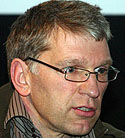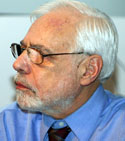| Global Television | ||||
|
Thursday, March 13, 2008 Roberta Pearson is Professor of Film and Television Studies and Director of the Institute of Film and Television Studies at the University of Nottingham. Among her books are Cult Television (2004) and Reading Lost: Perspectives on a Hit Television Show (2008). She is now working on The Blackwells Companion to Television Genre. William Uricchio is Professor and Co-Director of the MIT Comparative Media Studies Program and professor of Comparative Media History at Utrecht University in the Netherlands. His most recent books include Media Cultures (2006), on responses to media in post 9/11 Germany and the U.S., and the forthcoming We Europeans? Media, New Collectivities and Europe. Moderator: David Thorburn is professor of literature and director of the Communications Forum at MIT. He is the author of Conrad’s Romanticism, and, most recently, co-editor of Rethinking Media Change: The Aesthetics of Transition. A downloadable podcast of Global Television is now available. A webcast of Global Television is available. [this is an edited summary, not a verbatim transcript]
William Uricchio began by asking how many in the audience had watched TV internationally and seemed surprised by the number that had. His focus, he explained, would be on American and European television. To understand the role of media in helping to define a changing Europe, Uricchio and his research colleagues went to locations where identity was being contested. Visiting a Basque television station, the research team expected to see programs devoted to the unique aspects of Basque culture. Instead, they watched the production of a localized version of Wheel of Fortune. “What does this say about culture?” he asked. “What are they fighting for?” Uricchio described some “entry points” for understanding the globalization of television, ways in which the TV culture of one nation can make an impact on another society.
Roberta Pearson focused on U.S. television in Great Britain. In the 1950s American programming was viewed negatively, as vulgar and dumbed-down. American TV’s reputation improved in the 60s and 70s, but it dipped again in the late 70s and 80s, especially with the emergence of Dallas. Most American programming was broadcast in the evenings and was aimed at a youthful audience. Today, according to Pearson, the situation has changed radically; U.S. programming is widely admired in Britain. One explanation for this transformation is that American production companies are seeking new revenue sources at a time when publicly-funded European stations are facing severe budget cuts. Their acceptance of American programs generates far less opposition because U.S. content is now believed to represent the best of television. Eggo Muller offered an overview of the internationalization of program formats. Format sales are among the fastest growing financial sectors in television production. Global trade in formats is currently estimated at between $1-2 billion. The U.K., Scandinavia and Germany are among the leading format exporters. For the first time, according to Muller, the U.S. faces serious competition from Europe in TV production. Europeans feel they “get” reality programming better than Americans and have been successful in bringing reality formats to the US.
What exactly are formats? Essentially, they're programming ideas, not finished products, and in many countries they can't be copyrighted. But the industry needs the notion of formats in order to conduct international trade. Formats involve more than specific content expectations; they include the production strategies that define key subgenres of reality programming -- for example, competition shows such as Suvivor or law enforcement series like America's Most Wanted. Specific forms of “knowledge” are also part of the commerce in formats -- which audiences are likely to watch the program, how to approach advertisers about the program, etc. The trade in formats, Muller said, is an exchange in the culture of production rather than in the production of culture. Muller showed a scene from America's Most Wanted, which he said many would identify as a definitively American program. It is not. It is based on Crime Watch UK, a similar program that aired in Britain in the mid-1980s. But the British program was not the originator of the format. It first appeared on German television in the late 1960s. This genealogy is an example of the role and flexibility for formats because it shows that the trade in formats is not about the export or trade in culture. While formats may carry certain recognizable elements, the content is always nationalized, adapted for different national markets and cultures. Even with its original German roots exposed, it would be difficult to argue that America's Most Wanted carried elements of German culture to the American audience. Uricchio said it was important to recognize that there was a bigger change taking place in television that the panel hadn't addressed – the rise of IPTV, YouTube and other content channels available on line that are creating a broader new reality. The panel, he said, had focused on formal institutional practices, but there are other major changes taking place.
David Thorburn, moderating the discussion, said that when this forum was announced, a colleague from Women’s Studies asked him to share this story. During a visit to Mali, her driver brought her to his home to introduce her to his extended family, a polygamous household living in a large compound. When they arrived, she found two wives and many children gathered around a television. They were watching a program, dubbed in French that took her a few minutes to recognize. It was Big Love, HBO's show about polygamy. Thorburn asked the panelists whether the easy adaptability of formats to local cultures demonstrated that television has become a shared experience in much of the world. Uricchio agreed that was true for certain formats – especially those based on voyeurism – which seemed to have universal appeal. But there were others that certainly showed distinct cultural adaptation. Muller agreed on the issue of voyeurism, but went a step further. While programs like Big Brother can invite voyeurism, they also deal with the reality that all of us function in “non-choice” relationships, perhaps a more compelling reason for the show’s appeal across cultures. He also suggested that we can't assume all elements of a format will translate to all cultures. Uricchio pointed out that that another reason for Hollywood's success is the predictability and redundancy of its content. If you were to look at European content – particularly films - you would find much less reliance on formula and genre. In terms of television, the Europeans seem to have caught on and are creating formulaic content that is being fed back into the US through formats. Thorburn suggested that a number of recent American programs seem to be created with international markets in mind. The multicultural cast and settings of Heroes are a prime example of this trend. He asked the panel to provide examples that illustrate differences in the way in which particular formats are adapted for the needs of specific national or local cultures. Muller cited crime reality shows like America's Most Wanted, which must deal with national laws and differing attitudes toward crime and punishment. The history of this genre, he explained, involves a complex history of policy debates, legal discussions, etc. Although all versions of Most Wanted tend to focus on capital crimes, they depict the crimes and perpetrators differently depending on the country – the way the crimes are reenacted, for example, or how people are interviewed on the programs. Some of the things that are shown on the American program wouldn't appear on Dutch television. Uricchio offered a striking example of this localizing impulse. He described watching a CNN broadcast of a 9/11 Memorial in 2001. His wife was watching the same program on CNN International. During the program, Uricchio (who could hear that the soundtrack to the program his wife was watching was the same) commented on a specific image. It turned out that the images shown to domestic and international viewers were not the same. Discussion QUESTION: Can we consider global television from a different angle? Is there space to consider a new aesthetics, so you can have something that isn't driven by market forces?. PEARSON: You raise the issue of aesthetics, but it's something I am ambivalent about; even in industrial TV there are many aesthetic drivers; there is a much closed network around the quality shows but quality TV still draws from many sources. URICCHIO: This idea of aesthetic diversity works better for film than for television; Hollywood has always been a multicultural place – which has allowed it to reach broad audiences around the world. Part of this has been the result of polyglot production. MULLER: Even though it is economically driven, the change in the culture of production influences the culture that is produced. As far as I can see, game shows and reality shows (for example) deal with issues differently than a drama would. It's important to remember that TV reflects societies as well as the individual in society. PEARSON: It's also important to recognize that TV and movies are merging. Television programs are being packaged to appeal to global audiences with polyglot casts, crews, production and locations. QUESTION: Can you address non-broadcast distribution systems and the impact they have on the way we think of content and communities? URICCHIO: What's really interesting about IPTV are the conflicts it is engendering. Not just commercial issues but also what happens to programs when the context is removed. There are some concerns that specific communities are coping with non-acculturation through consumption of old cultural content (the Turkish community is Germany is an example). In this case, though, the content is being delivered through traditional channels and the context remains intact. But in other cases that does not happen and a false sense of the past – and an isolation from the present – can occur. PEARSON: In Britain, and perhaps elsewhere, many viewers are eager to keep up to date with the most popular American series. They turn to alternate distribution channels when their broadcast system lags a season (or more) behind that of the U.S. This is one of the reasons the television industry is working on a global regime. If markets are not in synch, consumers will seek alternate channels. MULLER: We're in a period of change, and how people get their content varies. In the U.S., audiences seem to favor the iTunes model. You see less downloading of programs here in the U.S. In Holland, on the other hand, many people watch illegal content. QUESTION: Six of top ten rated programs in Los Angeles are Spanish-language shows produced by Telemundo. It struck me that this is a cultural transfer we're not paying attention to. Does this even matter? PEARSON: We must still consider broadcast systems before thinking about the Internet when it comes to audience measurement. We need to examine broadcast production and distribution when we look at the diversity of American disaporic communities and TV. URICCHIO: Hispanics are an overlooked group from a media measurement perspective – huge but only selectively visible for a variety of reason. This makes them an important group to understand but one that is difficult to quantify.
|
||||




